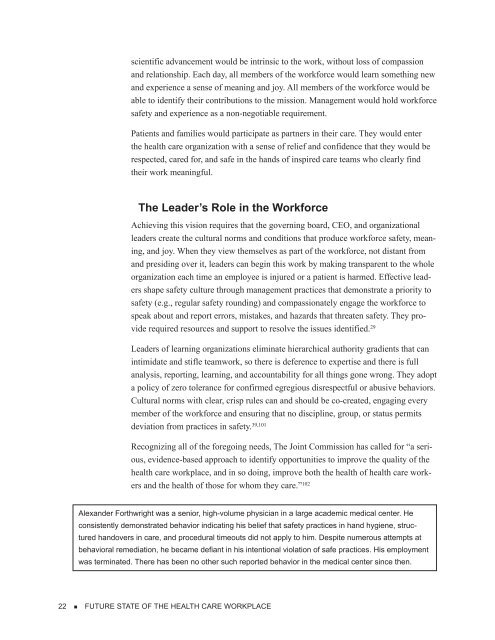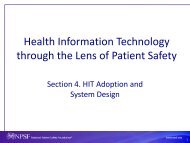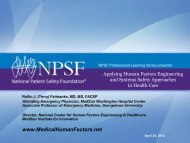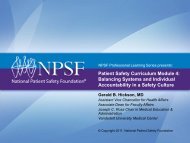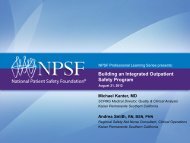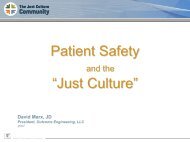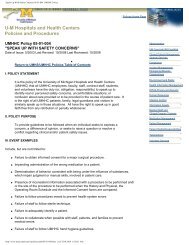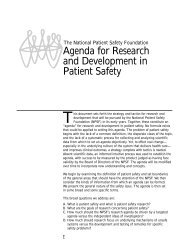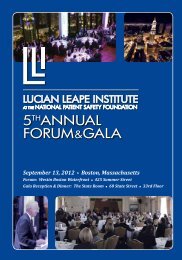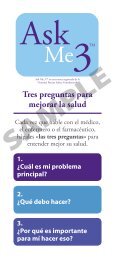Through The eyes of The Workforce - National Patient Safety ...
Through The eyes of The Workforce - National Patient Safety ...
Through The eyes of The Workforce - National Patient Safety ...
You also want an ePaper? Increase the reach of your titles
YUMPU automatically turns print PDFs into web optimized ePapers that Google loves.
scientific advancement would be intrinsic to the work, without loss <strong>of</strong> compassionand relationship. Each day, all members <strong>of</strong> the workforce would learn something newand experience a sense <strong>of</strong> meaning and joy. All members <strong>of</strong> the workforce would beable to identify their contributions to the mission. Management would hold workforcesafety and experience as a non-negotiable requirement.<strong>Patient</strong>s and families would participate as partners in their care. <strong>The</strong>y would enterthe health care organization with a sense <strong>of</strong> relief and confidence that they would berespected, cared for, and safe in the hands <strong>of</strong> inspired care teams who clearly findtheir work meaningful.<strong>The</strong> Leader’s Role in the <strong>Workforce</strong>Achieving this vision requires that the governing board, CEO, and organizationalleaders create the cultural norms and conditions that produce workforce safety, meaning,and joy. When they view themselves as part <strong>of</strong> the workforce, not distant fromand presiding over it, leaders can begin this work by making transparent to the wholeorganization each time an employee is injured or a patient is harmed. Effective leadersshape safety culture through management practices that demonstrate a priority tosafety (e.g., regular safety rounding) and compassionately engage the workforce tospeak about and report errors, mistakes, and hazards that threaten safety. <strong>The</strong>y providerequired resources and support to resolve the issues identified. 29Leaders <strong>of</strong> learning organizations eliminate hierarchical authority gradients that canintimidate and stifle teamwork, so there is deference to expertise and there is fullanalysis, reporting, learning, and accountability for all things gone wrong. <strong>The</strong>y adopta policy <strong>of</strong> zero tolerance for confirmed egregious disrespectful or abusive behaviors.Cultural norms with clear, crisp rules can and should be co-created, engaging everymember <strong>of</strong> the workforce and ensuring that no discipline, group, or status permitsdeviation from practices in safety. 39,101Recognizing all <strong>of</strong> the foregoing needs, <strong>The</strong> Joint Commission has called for “a serious,evidence-based approach to identify opportunities to improve the quality <strong>of</strong> thehealth care workplace, and in so doing, improve both the health <strong>of</strong> health care workersand the health <strong>of</strong> those for whom they care.” 102Alexander Forthwright was a senior, high-volume physician in a large academic medical center. Heconsistently demonstrated behavior indicating his belief that safety practices in hand hygiene, structuredhandovers in care, and procedural timeouts did not apply to him. Despite numerous attempts atbehavioral remediation, he became defiant in his intentional violation <strong>of</strong> safe practices. His employmentwas terminated. <strong>The</strong>re has been no other such reported behavior in the medical center since then.22 • future STATE OF THE HEALTH CARE WORKPLACE


